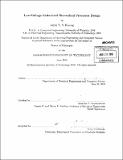| dc.contributor.advisor | Anantha P. Chandrakasan. | en_US |
| dc.contributor.author | Kwong, Joyce Y. S. (Joyce Yui Si) | en_US |
| dc.contributor.other | Massachusetts Institute of Technology. Dept. of Electrical Engineering and Computer Science. | en_US |
| dc.date.accessioned | 2011-03-07T15:19:22Z | |
| dc.date.available | 2011-03-07T15:19:22Z | |
| dc.date.copyright | 2010 | en_US |
| dc.date.issued | 2010 | en_US |
| dc.identifier.uri | http://hdl.handle.net/1721.1/61587 | |
| dc.description | Thesis (Ph. D.)--Massachusetts Institute of Technology, Dept. of Electrical Engineering and Computer Science, 2010. | en_US |
| dc.description | Cataloged from PDF version of thesis. | en_US |
| dc.description | Includes bibliographical references (p. 180-190). | en_US |
| dc.description.abstract | Advances in mobile electronics are fueling new possibilities in a variety of applications, one of which is ambulatory medical monitoring with body-worn or implanted sensors. Digital processors on such sensors serve to analyze signals in real-time and extract key features for transmission or storage. To support diverse and evolving applications, the processor should be flexible, and to extend sensor operating lifetime, the processor should be energy-efficient. This thesis focuses on architectures and circuits for low power biomedical signal processing. A general-purpose processor is extended with custom hardware accelerators to reduce the cycle count and energy for common tasks, including FIR and median filtering as well as computing FFTs and mathematical functions. Improvements to classic architectures are proposed to reduce power and improve versatility: an FFT accelerator demonstrates a new control scheme to reduce datapath switching activity, and a modified CORDIC engine features increased input range and decreased quantization error over conventional designs. At the system level, the addition of accelerators increases leakage power and bus loading; strategies to mitigate these costs are analyzed in this thesis. A key strategy for improving energy efficiency is to aggressively scale the power supply voltage according to application performance demands. However, increased sensitivity to variation at low voltages must be mitigated in logic and SRAM design. For logic circuits, a design flow and a hold time verification methodology addressing local variation are proposed and demonstrated in a 65nm microcontroller functioning at 0.3V. For SRAMs, a model for the weak-cell read current is presented for near-V supply voltages, and a self-timed scheme for reducing internal bus glitches is employed with low leakage overhead. The above techniques are demonstrated in a 0.5-1.OV biomedical signal processing platform in 0.13p-Lm CMOS. The use of accelerators for key signal processing enabled greater than 10x energy reduction in two complete EEG and EKG analysis applications, as compared to implementations on a conventional processor. | en_US |
| dc.description.statementofresponsibility | by Joyce Y. S. Kwong. | en_US |
| dc.format.extent | 190 p. | en_US |
| dc.language.iso | eng | en_US |
| dc.publisher | Massachusetts Institute of Technology | en_US |
| dc.rights | M.I.T. theses are protected by
copyright. They may be viewed from this source for any purpose, but
reproduction or distribution in any format is prohibited without written
permission. See provided URL for inquiries about permission. | en_US |
| dc.rights.uri | http://dspace.mit.edu/handle/1721.1/7582 | en_US |
| dc.subject | Electrical Engineering and Computer Science. | en_US |
| dc.title | Low-voltage embedded biomedical processor design | en_US |
| dc.type | Thesis | en_US |
| dc.description.degree | Ph.D. | en_US |
| dc.contributor.department | Massachusetts Institute of Technology. Department of Electrical Engineering and Computer Science | |
| dc.identifier.oclc | 703593754 | en_US |
